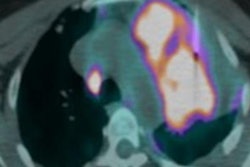
Machine-learning models can predict whether a CT-guided transthoracic biopsy will have complications and if so, how severe they will be, according to researchers from the University of Pennsylvania in Philadelphia.
After training and testing machine-learning models on CT-guided biopsies from nearly 1,500 patients, the researchers found that the algorithms could produce a high level of accuracy for predicting complications and their severity.
"But more importantly, [they could] identify that technical procedural factors mattered the most, and delineate specific factors and their relative importance, thereby allowing an actionable prescription to optimize procedural technique and improve patient safety of transthoracic biopsies," said Dr. Eduardo Mortani Barbosa Jr., who presented the findings in a talk at ECR 2021.
CT-guided transthoracic biopsies are minimally invasive procedures with excellent diagnostic yield, according to Barbosa. In their retrospective study, the researchers utilized machine-learning models to predict the factors associated with complications based on 1,487 CT-guided transthoracic biopsies that were performed between 2013 and 2018 at their institution. The 1,487 procedures included 1,249 lung biopsies.
The researchers collected a wide range of variables, including patient demographics, lesion characteristics, patient risk factors, and biopsy technique. The outcomes in the study included the presence of complications (pneumothorax, bleeding, and systemic air embolization), as well as the severity of complications (none, minor, and major) as defined by the Society of Interventional Radiology's guidelines, Barbosa said.
Of the 1,487 biopsies performed in the study, 355 (23.9%) had complications. These included 328 (22.1%) minor complications -- most commonly pneumothorax during lung biopsies, Barbosa said. Overall, pneumothorax occurred in 261 cases (17.6%) and bleeding resulted in 92 (6.2%) of the cases. There were 2 (0.1%) cases of air embolism.
Only 26 (1.7%) of the patients had major complications that were clinically consequential, Barbosa said.
The researchers trained three types of machine-learning models, including multivariate logistic-regression, gradient-boosted trees, and bootstrap random-forest classifiers. They used 75% of the cases for training and 25% for validation, and they also performed 10-fold cross-validation, according to Barbosa.
The multivariate logistic-regression model found that the statistically significant predictors of complications were, in order:
- Greater distance of aerated lung crossed
- Needle approach closer to vertical
- Greater number of biopsy passes
- Biopsy side in nondependent position
The other variables were not statistically significant, Barbosa said.
| Performance of bootstrap random-forest machine-learning algorithm for predicting complication and severity | |||
| Major complications | Minor complications | No complications | |
| Area under the curve | 0.93 | 0.76 | 0.79 |
In other results, the gradient-boosted trees model yielded an area under the curve of 0.77 for predicting whether a biopsy would have a complication.
"It [also] confirmed a similar set of variables that were proven to be statistically significant in the multivariate logistic-regression models," Barbosa said.




















